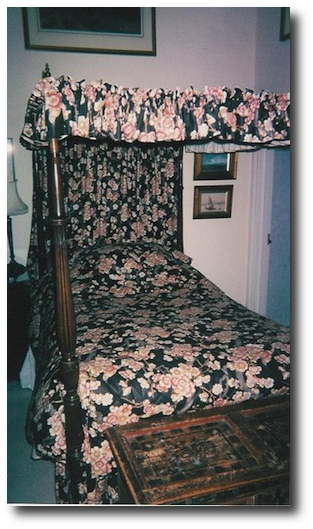‣ Sleeping in Byron's Bed
The story...In the autumn of 1998, I decided to visit London. The trip from Los Angeles is a long one in miles, in history, and in culture - and I wasn't at all sure why I was going. It was just something I felt I needed to do.I arranged to stay in a private home just around the corner from the Victoria & Albert Museum. The owner was a Mrs. Elliot. As I was getting ready for bed that first night, feeling confused and a bit lost, wondering why I had come to this city of strangers where I had no reason to be, she appeared at the door of my room. "By the way," she chirped, "you're sleeping in Lord Byron's camp bed." Suddenly I knew I was exactly where I wanted to be! The bed was inherited by Mrs. Elliot from an eccentric aunt who once lived in a suite of rooms at Newstead Abbey, Lord Byron's ancestral home. The bed (pictured below) was short and impossibly uncomfortable for any modern human, but it was the real thing (minus these particular chintz draperies). The bed was one of two made specifically to Lord Byron's instructions and taken with him when he galloped off to join the partisan fighters in Greece. The four-poster can be completely disassembled and packed for travel using the brass fasteners, two of which you can just make out near the top and bottom of the post in the left foreground. Sleeping in Byron's bed quickly became a metaphor for my visit to London as I met people with ties to artists of the past, many with close personal connections through a web of friendships and family relations. In the rootless, disconnected culture of the American west to which I am accustomed, no such web of relationships exists; art and intellect, more often than not, must survive in a vacuum. For me, it was a whole new way of looking at art - as a continuum, a river. The phrase "sleeping in Byron's bed" came to represent the perception of a long, unbroken line of artists who share an intimate relationship through their struggle to communicate their emotions. I had this feeling when I went to visit Keats' house - he seemed so present and real - and again when I went to Cambridge, and again on Cheyne Walk where Rosetti and Ruskin lived and worked and hung out. I realized that we all struggle with the same issues; some days we feel we have no talent at all, even Keats, even Van Gogh. We all dream the same dreams. We all sleep in the same bed - the poet's bed. |
Factoids
|
The first verse lyric "Are you capable of living with uncertainty..." is a paraphrase of poet John Keats' Theory of Negative Capability. Mrs. Elliot sold the bed and nightstand in 1999 for $20,000 to a collector of Byron memorabilia. I'm glad I got to sleep in it first. After posting my story about Byron's bed, I received a wonderful email from Derrick Leigh with a great example that illustrates exactly what I describe in my article. With his permission, I'm including it here. "I always felt some vague affinity with the romantic poets and the pre-Raphaelites, but then my sister's genealogical research uncovered some things that surprised me. One branch of the family tree contained a guy called Chandos Leigh, who was who was at Harrow school with Byron. They became friends, and when Byron got married Chandos bought his old bachelor pad. They dined together the evening Byron left the country. "Chandos's father was Henry James Leigh, who gave his name to Leigh Hunt, whose American father Isaac was his tutor. Chandos paid half the rent on Leigh Hunt's house when he ran into difficulties, the other half being paid by Mary Shelley. "It's hard to describe how this knowledge has affected me, but it's strengthened my artistic understanding of their lives and work and somehow brought them closer to the present day. It's given me confidence and inspired me." |
 Lord Byron's camp bed. In his book Joy Unconfined: Lord Byron's Grand Tour Re-toured, Ian Strathcarron records that Byron traveled in 1809 with four army beds and four camp beds. It's very likely that this is one of the camp beds. |
Sleeping In Byron's Bed - Buy it at CD Baby Words & Music by Robin Frederick When you're sleeping in Byron's bed Tangled thoughts will fill your head Sleeping in the poet's bed You must keep the hunger fed Are you capable of living with uncertainty and mystery Can you turn your back on fact and reason... When a sense of beauty leads you toward destruction will you weaken, will you hide, or will you let these voices tell you things from somewhere deep inside you When you're sleeping in Byron's bed Tangled thoughts will fill your head Sleeping in the poet's bed You must keep the hunger fed Maybe if you write it down you'll find some kind of sense in all this Maybe if you write it down you'll feel a little better But the words become a storm that lifts you higher than the faint horizon Followed by an empty feeling Maybe you should take up painting. Visions float before you and you fix the broken song as you chant the list of stolen words you feared you never find Then your voice becomes the river flowing on through endless years She will teach you how to worship if you offer up your tears. When you're sleeping in Byron's bed Tangled thoughts will fill your head Sleeping in the poet's bed You must keep the hunger fed Copyright 2002 Robin Frederick. All rights reserved. Used by permission. |
Robin has written more than 500 songs for television, records, theater, and audio products. She is a former Director of A&R for Rhino Records , Executive Producer of 60 albums, and the author of "Shortcuts to Hit Songwriting" and Shortcuts to Songwriting for Film & TV." Robin's books are used to teach songwriting at top universities and schools in the U.S. They're fun to read and filled with practical, real world information. Buy them at Amazon.com... Shortcuts to Hit Songwriting Shortcuts to Songwriting for Film & TV |





